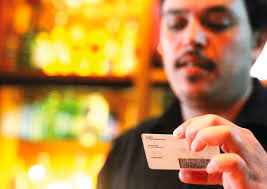How to Spot Reliable Fake IDs
Introduction: Understanding Fake IDs
In today's digital age, fake IDs have become a major concern in various industries, from bars and nightclubs to online shopping platforms and even government services. But what makes a fake ID "reliable," and how can you spot one before it's too late? In this article, we’ll dive deep into the world of fake IDs, helping you understand the characteristics, intricacies, and modern techniques involved in creating these counterfeit documents. Whether you're an industry professional, a curious observer, or someone who has encountered fake IDs in the past, this guide will arm you with the knowledge you need to separate the real from the fake.
Section 1: What Are Fake IDs?
Fake IDs, as the name suggests, are counterfeit identification cards designed to impersonate real government-issued IDs such as driver’s licenses, state IDs, or passports. While their most common use is to allow individuals to bypass age restrictions or gain access to restricted services, fake IDs can also be used for fraudulent activities, including identity theft, financial scams, and illegal immigration.
- The Evolution of Fake IDs
- Pre-Digital Era: Traditionally, counterfeit IDs were hand-crafted using physical tools like lamination, photocopying, and rudimentary editing.
- Digital Revolution: In the internet age, advanced software and printers allow for the production of highly sophisticated fake IDs.
- Current Trends: The rise of digital IDs and smartphone technology has further complicated the process of identifying counterfeit documents.
- Common Uses of Fake IDs
- Underage individuals trying to purchase alcohol or gain entry into age-restricted events.
- Fraudsters attempting to steal or assume another person’s identity.
- International cases where individuals may use fake IDs for crossing borders illegally.
Section 2: The Anatomy of a Fake ID
To spot a reliable fake ID, it’s crucial to understand the elements that make up a real identification card and how counterfeiters replicate or manipulate these features.
- Design and Layout
- Authenticity: Genuine IDs follow specific designs, dictated by the issuing government or state. These designs incorporate logos, fonts, and security features that are difficult to replicate.
- Counterfeit Variation: Fake IDs often have subtle or glaring design flaws, such as wrong fonts, color discrepancies, and inconsistent logos.
- Security Features
- Holograms and UV Marks: Many IDs include holographic images, UV-reactive elements, and special inks that change under light.
- Barcodes and Magnetic Strips: Real IDs include data strips and barcodes with encoded information, while fake IDs may have faulty or mismatched barcodes.
- Material Quality
- Plastic vs. Paper: Real IDs are typically made from high-quality plastic or a combination of durable materials. Counterfeit IDs may use cheaper plastic or paper materials, leading to issues with bending, texture, and longevity.
- Thickness and Feel: Real IDs feel thicker and more substantial. A counterfeit ID might feel flimsy or too light.
- Photo Quality and Lamination
- Facial Features: A real ID's photo should be clear and free from distortions. Fake IDs may have pixelated or blurry images, especially in the background.
- Lamination Quality: Real IDs are laminated with a uniform and seamless layer. Fake IDs may have visible edges or bubbles beneath the lamination.
Section 3: The Market for Fake IDs
Fake IDs are often sold on underground online markets, and the rise of dark web marketplaces has made it easier than ever for counterfeiters to reach customers. But how big is the market for fake IDs, and who are the primary buyers?
- The Demand for Fake IDs
- Underage Consumers: Young adults seeking access to alcohol, tobacco, clubs, or other restricted activities are one of the largest consumer bases for fake IDs.
- Criminals and Fraudsters: Identity theft, bank fraud, and credit card scams are some of the more nefarious uses of fake IDs.
- Immigrants and Refugees: In certain cases, individuals may use fake IDs to gain employment or access services that would otherwise be unavailable to them.
- Global Trends
- The demand for fake IDs isn’t limited to one region or country. It's a global issue that spans borders, with specific countries facing higher demand due to local regulations, age restrictions, and government controls.
- In countries with strict alcohol and tobacco laws, fake IDs are more commonly used by minors who wish to bypass legal age restrictions.
- The Technology Behind Fake IDs
- Fake IDs are often made using advanced technology, including high-end printing systems, laminating machines, and cutting-edge design software. Some counterfeiters even employ artificial intelligence to create increasingly convincing fakes.
- Many online vendors use complex packaging and shipping methods to mask the origins of their products, making it harder for authorities to track and intercept them.
Section 4: How to Spot a Fake ID
Now that we’ve explored the basics of fake IDs, it’s time to delve into the practical aspect—how to spot a reliable fake ID when you come across one. Below are some key areas to scrutinize.
- Examine the Photo
- Check for Pixelation or Distortion: Low-resolution images or distorted facial features are red flags. Genuine IDs have high-quality, sharp images.
- Lighting and Shadows: Ensure that the lighting in the photo matches the rest of the card, and that there’s no unnatural shadow or glow around the face.
- Feel the Material
- Check for Thin or Flimsy Texture: Fake IDs may feel too light or flexible. Real IDs have a sturdy, tactile feel to them.
- Check the Lamination: Run your fingers across the surface of the ID to check for smoothness. If you feel bumps, seams, or unevenness, it could be a fake.
- Inspect the Security Features
- UV Light Check: Use a UV light to inspect the card. A legitimate ID will often reveal hidden features that are invisible to the naked eye.
- Barcode Scan: Use a barcode scanner (or a smartphone app) to check if the encoded data matches the information on the front of the ID.
- Look for Design Flaws
- Inconsistent Fonts or Colors: Counterfeit IDs often have subtle discrepancies in font types, sizes, and colors that can be a giveaway.
- Watermark Check: Some IDs feature faint watermarks or ghost images that appear only when held up to a bright light.
Section 5: The Risks and Consequences of Using Fake IDs
While spotting a fake ID is important, it’s equally important to understand the consequences that come with using or distributing fake IDs. The risks are severe and can lead to legal troubles, fines, and even jail time.
- Legal Consequences
- Criminal Charges: Using a fake ID is illegal in most countries and can lead to charges of fraud, identity theft, and counterfeiting.
- Underage Drinkers: In many jurisdictions, minors caught with fake IDs can face fines, arrest, and the suspension of driving privileges.
- Financial Losses
- Identity Theft: If you’re caught with a fake ID that belongs to someone else, you could face charges of identity theft, resulting in long-term financial and legal issues.
- Credit and Bank Fraud: Fake IDs can be used to open bank accounts or make purchases, leading to severe financial losses for individuals and companies.
Section 6: Preventing Fake ID Use
To protect your business, community, or online platform from the misuse of fake IDs, it’s essential to implement measures to spot and prevent their use effectively.
- Training Staff
- Train employees to recognize the signs of fake IDs, including common design flaws, material issues, and security feature problems.
- Regularly update training materials to reflect new counterfeit techniques and technologies.
- Use of Technology
- Invest in ID scanning technology that can help verify the authenticity of ID cards and compare them against databases.
- Use barcode or magnetic stripe scanners to quickly validate the information contained on IDs.
- Heightened Awareness
- Keep up-to-date with emerging trends in counterfeit technology and adjust your procedures accordingly.
- Stay informed about local regulations and laws regarding the use and identification of IDs.
Conclusion: Stay Vigilant in the Age of Counterfeit Identification
Fake IDs are an unfortunate reality in today’s world, but with the right knowledge, tools, and awareness, we can spot them before they cause significant harm. By understanding the anatomy of a fake ID, knowing the risks involved, and implementing proper detection methods, you can better protect yourself, your business, and your community from the dangers of counterfeit identification.
 Realistic Arizona Fake ID
Realistic Arizona Fake ID
 Fake ID safety
Fake ID safety
 Illinois fake ID
Illinois fake ID
 fake ID trends
fake ID trends